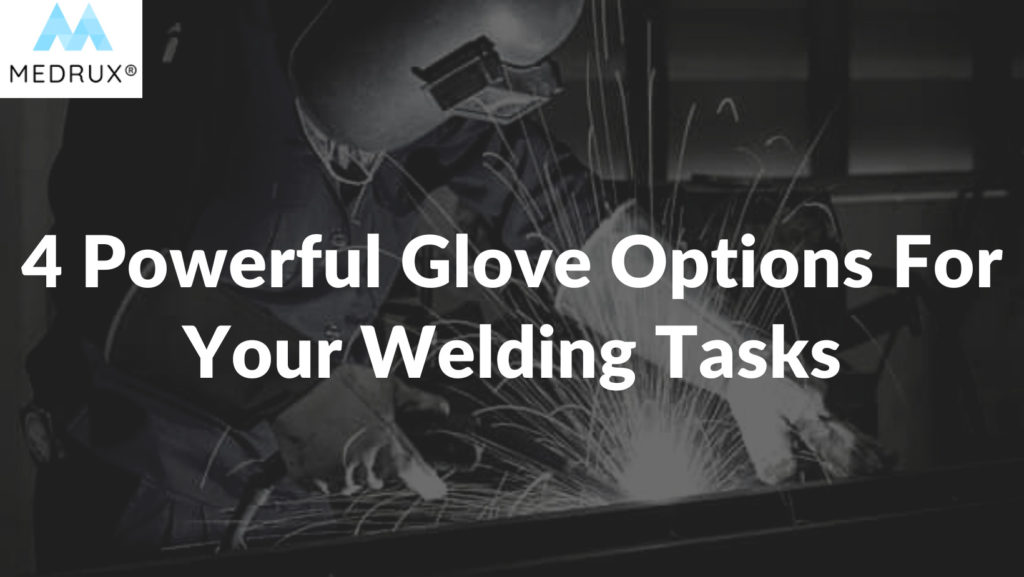Have you ever heard this workplace safety slogan, ” When you gamble with safety, you bet your life”?
Whether a true professional or starting, you’ll need the appropriate tools to finish your job.
For instance, take the case of heavy work jobs.
Heavy duty work includes the application of excessive force and physical power to complete a challenging task, which may require the use of machines and/or heavy tools on occasion.
Therefore, for your safety, you should wear proper clothing protection while working in any unfavorable or difficult situation, such as industrial safety gloves.
These industrial gloves are usually composed of thick materials with rough designs on the palms for better grip and less muscle fatigue.
They cover and support the hands and fingers while working on any project, protecting them against accidents or industrial injuries such as cuts, bruises, glass shards, tissue wounds, wood splinters, and burns from heat or chemicals.
Today’s scenario is working in welding jobs.
So, Have you worked as a welder lately?
Then, in that article, all you need to know about the proper pair of gloves.
All you need to do is to relax and try to read slowly.
Hopefully, you will find it enjoyable.
What are the Welding Gloves?
Welding can generate temperatures of up to 10,000 degrees Fahrenheit.
This means welding is a risky task, making wearing the proper gloves for the job critical to protecting both the wrist and the hands.
Welding gloves protect hands from heat, flames, and electric shock.
These gloves protect against electrical shock and boost grip and abrasion resistance.
Of course, the types of gloves vary depending on the welding process.
Welding is a multi-functional job; thus, your welding gloves must also be.
Those gloves should be worn during welding and all other tasks a welder must perform.
Finally, people who do not weld can also benefit from a good pair of gloves for domestic work involving intense heat, such as grilling or maintaining a backyard or outdoor fire pit.
Why do you need Welding Gloves?
As we mentioned, these gloves are one of several safety gloves for protection in any heavy-duty job.
But, ANSI Standard Z49.1 requires that all cutters and welders wear protective gloves.
Here is why it is vital if you are planning to perform any welding job to protect your hands with special gloves.
Studies have stated several accidents would happen in this environment quickly if welders were not wearing PPE.
For instance, electric shock, injuries, and skin burns are just a few risks that welders face if they don’t use hand protection.
Others would get their hands smashed, crushed between two things, or cut accidentally.
Furthermore, welders also face dangers that spark, hot metal, hot flying objects, dust, grime, grease, and chemicals.
For this reason, when you finally realize what your hands need, you can finally provide adequate protection for them at all times during welding operations.
What are the requirements for Welding Gloves?
The procedure determines the specific characteristics needed for choosing suitable gloves.
Here are some general features to look for: [1]
- Electrical insulation
- Heat insulation
- Moisture resistant
- Ability to keep the hands dry
- Flexible when working for a full range of motion
- Comfort: size and fit
- Quality materials: edges and seams that do not interfere with work
- Durable
- Long-lasting
- Puncture and tear-resistant
What materials are used in Welding Gloves?
The application is determined mainly by the material used.
Notably, the material usually used in manufacturing welding gloves is the best leather obtained from animal skins such as cows, swine, goats, and deer.
Leather is considered an excellent material for welding gloves, but you should also keep in mind its grade of it.
Additionally, the inner glove materials can be necessary as well.
For example, an inner glove made of wool or cotton may be needed if the work is done during a snowstorm or in a high-humidity atmosphere.
Welding Gloves classification according to the welding process
-
TIG Welding Gloves
TIG is short for Tungsten Inert Gas. [2]
TIG welding is an arc welding process that uses a non-consumable tungsten electrode and the workpiece to create the weld.
This type of welding requires significant skill and protection against heat.
TIG welders prefer gloves made of goatskin or another thin and malleable material because they are more durable.
This glove has extra padding across the palm and even on the outside of the hand.
Because the extra padding allows the fingers to rest comfortably next to hot surfaces.
Gloves are also designed to be easily removed when it becomes too hot.
However, one point you should be aware of is that gloves with Velcro straps might be challenging to remove.
This is particularly difficult when you need to remove the gloves fast due to the excessive heat.
Therefore, consider using a heat-resistant Kevlar or wool foam lining for further protection.
Usually, the efficacy of these gloves is checked by attempting to pick up something small, such as a coin.
But, if you find a problem picking it up, you must choose a different and more comfortable pair.
Finally, TIG gloves will not provide protection against hot processes like MIG, which creates a lot of spatter.
-
MIG Welding Gloves
MIG stands for Metal Inert Gas welding. [3]
MIG has been the most common welding procedure among professional and amateur welders for decades.
It is a type of welding in which electricity is used to melt both the feed wire and small sections of the metal workpieces, thereby soldering them together.
Unlike TIG welding, MIG produces more heat and sparks.
So, the ideal material for making gloves for this type of welding is high-quality goat skin with a heat-resistant liner.
As we said before, this is due to the excessive levels of heat, sparks, and harmful spatter produced during the MIG process.
Moreover, gloves must be thicker and contain multiple layers.
Other leather materials for making MIG gloves include top-grain cowhide, pig skin, or deer skin.
- Stick Welding Gloves
Stick welding is an industrial slang term for Shielded Metal Arc Welding. [4]
Stick welding uses electricity to melt the electrode.
Both the metal joint and the electrode are melted at the same time and fused.
It was initially used in the 1920s when the first flux-coated electrode was introduced.
However, it is now employed for welding bridges, construction, pipelines, and maintenance, among other things.
When it comes to sticking welding, a thicker leather cut is needed.
The split grains of goatskin and pigskin are the best candidates for these gloves.
Elk skins, unlike cowhides, do not harden fast when exposed to heat; thus, they can be utilized for making stick gloves.
Because stick welding procedures are simple, the user will not need a flexible glove.
Also, the gloves need to be thick and protective since this type of welding gives off a lot of heat and sparks compared to other welding processes.
-
Cut-resistant Gloves
When working with metal, there is a considerable risk of being cut or scratched.
While the incisions may not appear deep, the region may become infected, causing further harm to the hands.
Cut-resistant gloves are the safest option to ensure your safety when you must operate with blades and sharp items.
In other words, they are precisely designed to protect the glove from damage and the welder from injuries caused by sharp tools such as ceramics, glass, metals, etc.
What to consider when purchasing Welding Gloves?
Let’s keep these points in mind as the ultimate guide for getting a pair of welding gloves that will both protect and last: [5]
- Proper Size
One size does not fit all.
Ensuring your welding gloves fit is just as essential as how well they protect you.
Then, if your hands slide out or you don’t have enough room to move, you’ll be both uncomfortable and unsafe.
Furthermore, your gloves should not be bulky and comfortable; that provides you with freedom of movement.
Think about the type of thumb you desire.
To avoid inconvenience, consider buying welding gloves with extra leather on the thumb, index finger, and the hand’s metacarpus area.
You can also choose between gloves covering the hand or extending up to the elbow.
Then, you have to try gloves on before using them.
Besides, flex your hand, fingers, and wrists inside them and note how they feel and move.
-
The type of Welding Procedure
Welding gloves must be up to the task.
As we stated, they are available in several designs, styles, and materials.
These gloves must be inspected and certified to provide protection according to regulations and standards.
Significantly, you must consider the welding machine or technology used, such as we mentioned either: stick, MIG, TIG, or a combination of these methods.
Because the type of welding done will determine what types of gloves are appropriate for the task.
Take into consideration the working environment as well.
Because there’s a big difference between working inside a climate-controlled facility and outside on a 400-foot building with welding beams.
-
Type of Insulation
Welding is called hot work for a reason.
As your choice of welding glove will be influenced by the heat involved.
Then start with evaluating the heat involved.
Always keep the duration of heat exposure in mind.
Manufacturers and suppliers can assist you with the choice process, but you must provide them with information concerning the task required.
For example, when stick welding, consider the following:
- Welding over 90 amps: the glove should have Kevlar thread.
- 125 amps or more: the glove should have some cotton insulation.
- 250 amps or more: the glove should have cotton and foam insulation.
- Over 500 amps: the glove should have a backhand pad or a reflective material on the back of the hand.
Furthermore, learn about the various types of insulation to obtain the greatest protection.
Good insulators are made of Kevlar liners, cotton liners, and aluminum.
-
The Right Design
Aside from the actual welding period, welding involves a variety of tasks.
In other words, the welding task you undertake heavily affects your dexterity level.
Therefore, gloves must have an excellent non-slip grip and a reinforced flexible palm to properly use the chipping hammer and grinder as part of those demanding tasks.
These great gloves will allow you to do rough and heavy work and fine finger work.
For instance, MIG and stick welding requires high heat protection, while TIG welding requires gloves that will give welders high dexterity levels.
Finally, remember that there are both right and left-handed individuals worldwide, so glove supports and pads must be available in either direction or tailored for usage with either hand.
-
Follow the Manufacturer’s Care Instructions
Welding gloves must be cleaned carefully to maintain their protective characteristics.
Besides, your supplier may recommend the best method to clean, care for, and properly store your gloves.
How long do welding gloves last?
Welding gloves don’t last forever.
For this reason, you should understand when to replace your welding gloves.
Their shelf life is determined by the quality and frequency of use.
So, they will have a longer lifespan if exposed to moderate heat and fewer working hours than when exposed to high heat and a lot of effort.
Generally, if a quality pair of gloves is well-maintained, it should last a few months—perhaps two.
However, if they are damaged, torn, have holes, or are abraded to the degree where their integrity is compromised, they must be replaced immediately.
Thus, they will need replaced according to the manufacturer’s recommendations.
After all, a welding glove can protect you from electrical hazards, but only if there are no holes.
Welding Gloves VS Grilling Gloves
Earlier in this article, we mentioned that people who do not weld also could use these gloves.
In particular, the most common question on the internet is, “Can welding gloves be used for grilling?”
The answer is yes, of course.
Both types of gloves are already manufactured to be heat resistant.
However, welding gloves are much better in terms of protection against heat.
You may have already bought your welding gloves for your welding job and then decided to have a grilling party with family and friends at home.
In this case, you do not have to purchase another protective glove.
This PPE is, of course, not cheap.
But if not yet, and you still want to know more about the difference, then please continue reading.
BBQ or grilling gloves can safeguard hands from temperatures ranging from 500 to 1000 degrees Fahrenheit or 260 to 600 degrees Celsius.
Besides, These grilling gloves could provide benefits like comfort, ease of cleanup, and resistance to oil and water.
Both are made of leather, the first choice in the case of heat resistance characteristics.
The only drawback here is that if the glove becomes overheated, you should remove it immediately unless you want to burn yourself.
In addition, we noticed that welding gloves are much more popular on the online market than grilling gloves.
However, in terms of price, it is different because welding needs better protection than grilling or managing campfires.
Welding gloves are super tough due to their industrial application but are also adequately malleable to be worn for extended periods.
It is also possible to move the wrist and fingers to grab anything, which might be necessary when dexterity is required quickly.
Ultimately, they are an ideal alternative for individuals who must maneuver around hot grills because these welding gloves stretch up to 18 inches up the forearm.
Conclusion
The appropriate PPE requires a collaborative effort from the welder to the safety professional to the designer and manufacturer.
Together, you should be able to find gloves that are both task-specific and a suitable fit for the customer.
Also, note that the appropriate welding gloves for you will be different than for someone else.
Keep these last-mentioned tips in mind when you shop for welding gloves and discover the right balance for you.
Always ask yourself, is protection from heat, splattering, or cuts more critical?
The choice you make has to be determined by the type of welding you’ll be conducting.
Each pair of gloves provides critical protection, but don’t forget to assess how well they’ll perform their job.
Take price into consideration as well.
In the end, I hope we managed to give the ultimate guide before your selection.
Stay happy and protected.







